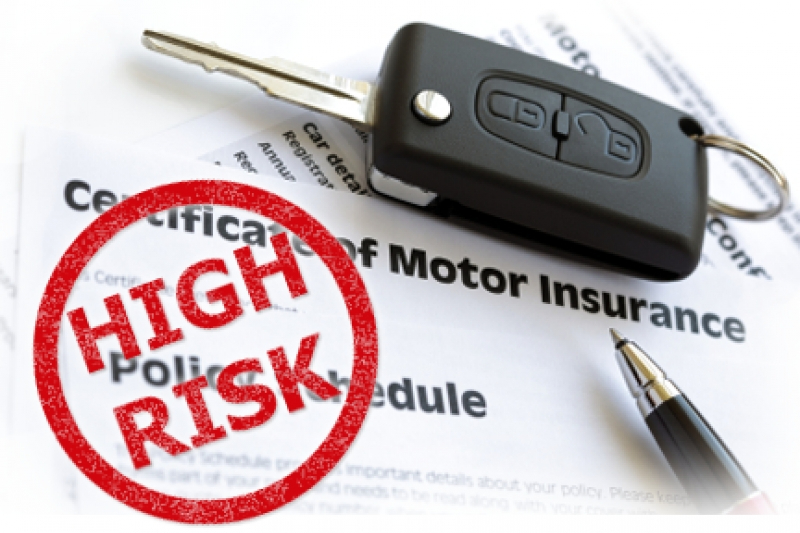What is High-Risk Auto Insurance and Why Might You Need It?
Explore what high-risk auto insurance is and why it might be necessary for certain drivers. Understand the reasons behind needing this type of coverage and how it can protect you on the road.

Navigating the world of car insurance can be daunting, especially if you find yourself classified as a high-risk driver. High-risk auto insurance is designed to cover drivers who have a history or current situation that poses a higher likelihood of filing a claim. Understanding what constitutes high-risk auto insurance, who might need it, and how it affects your coverage options is crucial for ensuring that you are adequately protected. In this article, we’ll delve into the concept of high-risk auto insurance, explore the factors that contribute to high-risk status, and discuss why it might be necessary for certain drivers.
What is High-Risk Auto Insurance?
High-risk auto insurance is a specialized type of coverage for drivers who are deemed more likely to file a claim due to their driving history or other risk factors. Unlike standard auto insurance policies, high-risk policies often come with higher premiums due to the increased risk perceived by insurance companies. These policies are designed to provide coverage for drivers who may have difficulty obtaining insurance through conventional means.
Who Qualifies for High-Risk Auto Insurance?
Several factors can contribute to a driver being classified as high-risk. These factors often include:
-
Driving History: Drivers with a history of multiple traffic violations, DUIs, or accidents are often categorized as high-risk. Frequent incidents suggest a higher probability of future claims.
-
Poor Credit Score: Insurance companies frequently use credit scores as a factor in determining risk. Drivers with poor credit scores may be considered higher risk and thus may face higher premiums.
-
Young or Inexperienced Drivers: Teen car insurance quotes are generally higher due to the lack of driving experience and statistically higher accident rates among younger drivers.
-
High Mileage: Drivers who cover high annual mileage may be seen as high-risk due to the increased probability of accidents.
-
Special Circumstances: This can include drivers with a history of insurance lapses, those needing SR-22 insurance due to legal requirements, or those who drive high-performance or classic cars.
Why Might You Need High-Risk Auto Insurance?
High-risk auto insurance might be necessary for several reasons:
-
Legal Requirements: In some cases, drivers may be legally required to maintain high-risk insurance, particularly if they have been convicted of serious traffic violations or have been involved in significant accidents.
-
Coverage for At-Risk Drivers: If you have been categorized as high-risk, obtaining insurance through standard providers may be challenging. High-risk auto insurance ensures you remain covered and compliant with state regulations.
-
Financial Protection: High-risk drivers may face higher premiums, but this coverage is essential for financial protection in case of an accident. It helps mitigate the financial burden that comes with vehicle repairs, medical expenses, and legal liabilities.
Factors Contributing to High-Risk Status
Several factors can contribute to a driver’s high-risk status:
-
Driving Record: A history of traffic violations, accidents, or DUIs will typically push you into the high-risk category. Insurance companies view these records as indicators of potential future claims.
-
Credit History: Poor credit history can affect your insurance rates. Insurers often use credit scores to gauge the likelihood of future claims, with lower scores indicating higher risk.
-
Vehicle Type: Certain vehicles, such as classic cars, high-performance cars, or electric cars, may be more expensive to insure due to their higher repair costs or increased likelihood of theft.
-
Mileage and Usage: High-mileage drivers or those using their vehicles for commercial purposes might face higher rates. Insurance companies assess the increased likelihood of claims based on vehicle usage.
How Insurance Companies Assess High-Risk Drivers
Insurance companies use various methods to assess high-risk drivers, including:
-
Driving History Reports: Insurers review your driving record to determine how many accidents, violations, or claims you have had. A history of frequent incidents generally leads to higher risk classification.
-
Credit Checks: Your credit score is used to assess your overall risk profile. Poor credit can indicate higher risk, leading to increased premiums.
-
Vehicle Information: The type and condition of your vehicle are considered. For example, commercial auto insurance policies might be required for those using their vehicles for business purposes.
-
Personal Information: Factors such as age, location, and even the purpose of driving (personal vs. commercial) can influence your risk level.
Finding the Best Rates for High-Risk Auto Insurance
If you find yourself needing high-risk auto insurance, there are strategies to manage and potentially reduce your premiums:
-
Compare Car Insurance Rates: Use online tools to compare car insurance rates and find the best options for high-risk drivers. This can help you find cheap car insurance for new drivers or low-cost car insurance tailored to your needs.
-
Look for Discounts: Many insurers offer discounts for things like accident forgiveness auto insurance, low-mileage car insurance, or bundling policies. Explore these options to potentially lower your premiums.
-
Consider Non-Owner Car Insurance Policies: If you don’t own a vehicle but need insurance, a non-owner car insurance policy might be a cost-effective option.
-
Explore Specialized Coverage: Depending on your situation, you might need specific coverage such as full coverage auto insurance, temporary car insurance, or no deposit car insurance.
-
Utilize Online Tools: Use online auto insurance comparison tools to find the best rates for your situation. Online auto insurance comparison can help you identify the most affordable options for high-risk drivers.
High-risk auto insurance is a vital option for drivers who face higher risks due to their driving history, vehicle type, or other factors. While it often comes with higher premiums, it ensures that drivers remain covered and protected against potential financial burdens. By understanding the factors that contribute to high-risk status and utilizing strategies to compare and find the best rates, you can manage your insurance costs effectively.
Whether you live in Louisville, Grand Rapids, Oklahoma City, Lansing, or Des Moines, it’s essential to find the right insurance coverage that meets your needs and provides adequate protection. Explore various options, utilize online resources, and consult with insurance providers to secure the best possible coverage for your situation.
Top 5 Tips for Finding Affordable High-Risk Auto Insurance
Finding affordable high-risk auto insurance can be challenging, especially if you have a history of accidents, traffic violations, or a less-than-stellar credit score. However, with the right strategies, you can find cheap car insurance that fits your needs. Here are five practical tips to help you secure the best rates:
1. Compare Car Insurance Rates Online
One of the most effective ways to find affordable high-risk auto insurance is by using online auto insurance comparison tools. Websites that provide car insurance quotes online allow you to compare rates from multiple insurers quickly. This way, you can find the best deal without having to contact each company individually.
When using these tools, make sure to enter accurate information to get the most precise quotes. Be sure to compare coverage options and not just the premium to ensure you’re getting the best value. For drivers in cities like Louisville, Grand Rapids, Oklahoma City, Lansing, and Des Moines, local insurers may offer unique discounts or coverage options that online tools might miss.
2. Improve Your Driving Record
A clean driving record is crucial for obtaining lower rates on your auto insurance. If you are categorized as high-risk due to previous accidents or violations, take proactive steps to improve your driving habits. Consider enrolling in a defensive driving course, which not only enhances your driving skills but may also qualify you for accident forgiveness auto insurance or other discounts.
Keeping your driving record clean over time will help reduce your risk profile and potentially lower your premiums. Additionally, insurers in Des Moines and Lansing may offer specific programs for drivers to improve their records and reduce rates.
3. Utilize Discounts and Coverage Options
Many insurers offer various discounts that can make high-risk auto insurance more affordable. Here are a few to consider:
- Low-mileage car insurance: If you drive infrequently, some insurers offer discounts for low mileage.
- Multi-vehicle car insurance discount: If you insure multiple vehicles with the same provider, you may qualify for a discount.
- SR-22 insurance: For drivers required to file an SR-22, some companies offer more affordable options for high-risk drivers.
In addition, check if you’re eligible for other auto insurance discounts for military, senior citizens, or students. For example, if you're a young driver or have a bad credit history, some insurers in Louisville or Grand Rapids may provide special rates or discounts tailored to your situation.
4. Consider Non-Owner Car Insurance Policy
If you don’t own a car but need insurance, a non-owner car insurance policy can be a cost-effective option. This type of coverage is ideal for individuals who frequently rent or borrow vehicles. It typically offers liability coverage but may not include comprehensive or collision coverage. It’s a good way to maintain insurance coverage without paying for a full policy, which can be especially beneficial for those with a high-risk profile.
5. Explore Alternative Insurance Options
In addition to traditional auto insurance, explore alternative options that might offer lower rates:
- Pay-per-mile car insurance: This can be a good option if you drive a minimal number of miles annually. Your premium is based on the miles you drive, which can lead to significant savings if you drive less.
- Liability-only car insurance: If you’re looking to cut costs, consider liability-only car insurance, which covers only damage you cause to others and their property. This type of policy is often cheaper than full coverage auto insurance.
For those looking for more specialized coverage, classic car insurance or electric car insurance might offer tailored options that suit your needs. Additionally, temporary car insurance can be useful if you need coverage for a short period.
Finding affordable high-risk auto insurance requires a combination of smart shopping, improving your driving habits, and exploring various insurance options. By leveraging car insurance quotes online, utilizing discounts, and considering alternative policies, you can find a solution that meets your needs without breaking the bank.
Remember to regularly review your insurance policy and shop around to ensure you’re getting the best possible rates. Drivers in Oklahoma City, Lansing, Grand Rapids, Louisville, and Des Moines should also keep an eye on local insurance providers and offerings, as regional differences can impact pricing and available discounts.
How High-Risk Auto Insurance Policies Differ from Standard Coverage
When it comes to car insurance, understanding the difference between high-risk auto insurance policies and standard coverage is crucial for drivers. This distinction not only affects the cost of your insurance but also the type of protection you receive. In this article, we'll delve into how high-risk auto insurance differs from standard policies, focusing on coverage, cost, and terms to help consumers make informed decisions.
Understanding High-Risk Auto Insurance
High-risk auto insurance is designed for drivers who are considered a greater risk to insurers. This classification can result from a variety of factors, such as a history of traffic violations, multiple accidents, driving under the influence, or having a poor credit score. In contrast, standard auto insurance is tailored for drivers with a clean driving record and fewer risk factors.
Coverage Differences
High-risk auto insurance policies often provide similar coverage types as standard policies, but with notable differences:
-
Coverage Options:
- High-risk policies may include more stringent terms or higher deductibles.
- Standard coverage usually offers a range of options including comprehensive auto insurance, collision coverage, and liability-only car insurance.
-
Add-Ons:
- Drivers with high-risk auto insurance might find it harder to add optional coverage like accident forgiveness auto insurance or classic car insurance.
- Standard insurance often includes more flexible options for add-ons, such as temporary car insurance or pay-per-mile car insurance.
Cost Differences
One of the most significant differences between high-risk and standard auto insurance is the cost. Here’s how they compare:
-
Premiums:
- High-risk auto insurance typically comes with higher premiums due to the increased risk of claims. This is because insurers perceive high-risk drivers as more likely to file a claim.
- Standard insurance usually has lower premiums as drivers are deemed less risky.
-
Discounts:
- High-risk drivers might have limited access to discounts such as multi-vehicle car insurance discount or auto insurance discounts for military.
- Standard insurance policies often provide various discounts, including low-mileage car insurance or cheap car insurance for new drivers.
-
Payment Options:
- High-risk auto insurance may require higher upfront costs or less flexible payment options. Drivers might face challenges finding no down payment auto insurance or no deposit car insurance.
- Standard insurance typically offers more payment flexibility, including options for no down payment auto insurance or cheap car insurance.
Terms and Conditions
Terms of high-risk auto insurance policies often differ from those of standard coverage:
-
Policy Limits:
- High-risk auto insurance may come with lower policy limits or stricter conditions on claims.
- Standard policies generally offer more favorable terms and higher coverage limits.
-
Exclusions:
- High-risk policies might have more exclusions or restrictions on coverage compared to standard policies.
- Standard auto insurance tends to offer broader coverage with fewer exclusions.
-
SR-22 Insurance:
- High-risk drivers may be required to file an SR-22 insurance form to prove financial responsibility, especially after serious violations.
- Standard insurance typically does not require an SR-22 form.
Comparing Auto Insurance Rates
When shopping for auto insurance, comparing rates is essential. Use online tools to get car insurance quotes online and find the best rates for your needs. Consider the following when comparing:
-
Coverage Needs:
- Determine whether you need full coverage auto insurance or if a liability-only car insurance policy would suffice.
- Evaluate whether commercial auto insurance or non-owner car insurance policy is necessary for your situation.
-
Policy Features:
- Check for additional features such as comprehensive auto insurance or accident forgiveness auto insurance.
- Look into low-cost car insurance options or online auto insurance comparison tools to find the best deals.
-
Location-Specific Rates:
- Insurance rates can vary by city. For example, car insurance in Louisville, Grand Rapids, Oklahoma City, Lansing, and Des Moines may differ based on local risk factors and insurance regulations.
Tips for Finding Affordable Coverage
If you're looking to reduce your insurance costs while maintaining adequate coverage, consider these tips:
-
Shop Around:
- Use online comparison tools to find best auto insurance rates and compare various providers.
-
Bundle Policies:
- Bundling auto insurance with other policies can often lead to discounts.
-
Improve Your Risk Profile:
- Work on improving your driving record and credit score to potentially lower your auto insurance costs.
-
Consider Different Types of Insurance:
- For specific needs, explore options such as electric car insurance or senior citizen auto insurance.
By understanding the differences between high-risk auto insurance and standard coverage, you can make more informed decisions about your auto insurance needs. Whether you’re in Louisville, Grand Rapids, Oklahoma City, Lansing, or Des Moines, taking the time to compare rates and coverage options will help you find the best insurance policy for your situation.
The Impact of High-Risk Auto Insurance on Your Premiums and Coverage
Navigating the world of high-risk auto insurance can be daunting, especially if you’re classified as a high-risk driver. Whether it’s due to a history of traffic violations, multiple accidents, or a less-than-stellar credit score, being labeled as high-risk often comes with significant consequences for your car insurance premiums and coverage options. In this guide, we’ll delve into how being a high-risk driver affects your insurance rates and coverage, and explore strategies for potentially lowering premiums and improving your coverage, all while targeting major cities such as Louisville, Grand Rapids, Oklahoma City, Lansing, and Des Moines.
Understanding High-Risk Auto Insurance
High-risk drivers are typically those who have a higher likelihood of filing a claim. Insurers classify drivers as high-risk based on several factors, including:
- Accidents: Multiple accidents or serious collisions.
- Traffic Violations: Speeding tickets, DUIs, or other moving violations.
- Driving History: A history of frequent claims or lapses in coverage.
- Credit Score: Poor credit scores can impact your risk profile.
- Vehicle Type: High-performance or luxury vehicles might attract higher premiums.
As a result, high-risk auto insurance often comes with steeper premiums and more limited coverage options compared to standard policies.
How High-Risk Classification Affects Your Insurance Premiums
When classified as a high-risk driver, your car insurance quotes online will likely be higher. This is because insurance companies see you as more likely to file a claim, which means they anticipate higher costs for coverage. Here’s a breakdown of how high-risk classification impacts your premiums:
-
Increased Premiums: High-risk drivers often face significantly higher auto insurance rates. Insurers adjust premiums based on perceived risk, and high-risk drivers typically fall into higher price brackets.
-
Limited Coverage Options: Insurers might offer fewer options for full coverage auto insurance or comprehensive auto insurance to high-risk drivers. This can lead to a more basic policy with less protection.
-
Higher Deductibles: In some cases, high-risk drivers may have to pay higher deductibles before their insurance coverage kicks in.
Strategies to Lower Premiums Despite High-Risk Classification
Even if you’re classified as a high-risk driver, there are several strategies you can use to potentially lower your premiums and improve your coverage:
1. Compare Car Insurance Rates
One of the most effective ways to find cheap car insurance for new drivers or high-risk drivers is to compare car insurance rates from different providers. Using online tools to compare car insurance rates can help you find the most affordable options available in your area.
2. Look for Discounts
Insurance companies often offer various discounts that you might qualify for, even as a high-risk driver. These can include:
- Accident Forgiveness Auto Insurance: This can prevent your first accident from impacting your rates.
- Low-Mileage Car Insurance: If you drive less frequently, you might qualify for lower rates.
- Multi-Vehicle Car Insurance Discount: Insuring multiple vehicles with the same provider can sometimes reduce your premiums.
3. Improve Your Driving Record
Working to improve your driving record can eventually help lower your insurance premiums. Avoid traffic violations, take defensive driving courses, and maintain a clean driving history to gradually improve your risk profile.
4. Consider a Higher Deductible
While it might seem counterintuitive, opting for a higher deductible can sometimes lower your monthly premiums. Just make sure you can afford the deductible if you need to make a claim.
5. Maintain a Good Credit Score
If your credit score impacts your insurance rates, work on improving it. Paying bills on time, reducing debt, and monitoring your credit report can all contribute to better rates.
6. Explore Non-Owner Car Insurance Policy
If you frequently drive different cars but don’t own one, a non-owner car insurance policy might offer a cost-effective solution. This type of insurance can provide coverage while driving vehicles that don’t belong to you.
7. Seek Low-Cost Car Insurance
If you’re looking for low-cost car insurance, consider policies that provide only the essential coverage required by law. While these policies might not offer extensive protection, they can be a budget-friendly option for high-risk drivers.
Improving Coverage Options
Despite being a high-risk driver, there are still ways to ensure you have adequate coverage:
-
Full Coverage Auto Insurance: Opting for full coverage auto insurance ensures you have protection for both liability and physical damage to your vehicle. This can be especially important if you drive a high-value or newer vehicle.
-
Comprehensive Auto Insurance: Comprehensive auto insurance covers non-collision-related damages such as theft, vandalism, and natural disasters, providing broader protection.
-
SR-22 Insurance: If required by your state, SR-22 insurance is a form of high-risk insurance that proves you have the minimum liability coverage required by law.
-
Consider Temporary Car Insurance: If you only need insurance for a short period, temporary car insurance can be a flexible and often cheaper option.
-
Look into Electric Car Insurance: For those driving electric vehicles, electric car insurance might offer tailored coverage options and potential discounts.
Being classified as a high-risk driver can significantly impact your car insurance premiums and coverage options. However, by understanding how these factors affect your rates and taking proactive steps to lower premiums and improve coverage, you can find a policy that suits your needs. Utilize online tools to compare car insurance rates, look for applicable discounts, and explore different insurance options to find the best fit for your situation. Cities like Louisville, Grand Rapids, Oklahoma City, Lansing, and Des Moines offer various options for high-risk drivers, so make sure to explore local providers and tailor your insurance to your specific needs.
Success Stories: How Drivers Overcame High-Risk Status and Reduced Their Insurance Costs
High-risk drivers often face inflated auto insurance rates due to their driving history, age, or other factors. However, many individuals have successfully navigated this challenge, managing to lower their insurance costs through various strategies. This article shares real-life examples of such drivers and the methods they used to overcome their high-risk status, including improving their driving habits, seeking specialized insurance providers, and leveraging discounts. For those looking to save on car insurance, these success stories offer valuable insights.
1. John’s Journey to Better Rates in Louisville
John, a 35-year-old Louisville resident, struggled with high high-risk auto insurance premiums due to a few traffic violations and an at-fault accident. Determined to reduce his insurance costs, John adopted several strategies:
Improved Driving Habits
John took a defensive driving course to improve his driving skills and demonstrate his commitment to safer driving. Many insurers offer accident forgiveness auto insurance or discounts for completing such courses. This not only helped John drive more safely but also made him eligible for discounts on his car insurance quotes online.
Shopping Around for Quotes
John used online auto insurance comparison tools to compare rates from various providers. By doing so, he found a specialized insurance provider that offered better rates for drivers in his situation. This allowed him to secure more affordable full coverage auto insurance.
Adjusting Coverage
John reviewed his coverage needs and opted for a low-mileage car insurance policy, as he drove fewer miles than average. This adjustment further reduced his premiums. Additionally, he explored cheap car insurance for new drivers as a comparison to see if lower-cost options might be applicable.
2. Sarah’s Success in Grand Rapids
Sarah, a 28-year-old with a recent history of minor accidents, faced high premiums due to her SR-22 insurance requirement. Here's how she managed to reduce her car insurance costs:
Choosing the Right Provider
Sarah found an insurer specializing in SR-22 insurance that offered competitive rates for her specific needs. By opting for a provider familiar with high-risk insurance, she was able to secure a more affordable policy.
Increasing Deductibles
To lower her monthly payments, Sarah chose a higher deductible for her comprehensive auto insurance. This decision significantly reduced her premiums, as she was willing to take on more risk in the event of a claim.
Utilizing Discounts
Sarah took advantage of various auto insurance discounts for military (her spouse served) and multi-vehicle car insurance discount by adding her partner’s vehicle to the policy. This combination of discounts led to substantial savings on her car insurance quotes online.
3. Michael’s Strategy in Oklahoma City
Michael, a 42-year-old Oklahoma City resident, was dealing with high rates due to his status as a high-risk driver. His approach involved several key steps:
Improving Credit Score
Michael focused on improving his credit score, which positively impacted his auto insurance for bad credit. Insurers often consider credit scores when determining rates, and a higher score can lead to lower premiums.
Exploring Alternative Policies
Michael explored non-owner car insurance policy options, as he frequently rented cars. This policy was cheaper and provided the coverage he needed without the higher costs associated with traditional policies.
Seeking Specialist Providers
He reached out to insurance brokers who specialize in low-cost car insurance for high-risk drivers. These specialists were able to offer tailored solutions that significantly reduced his premiums.
4. Emma’s Approach in Lansing
Emma, a 30-year-old Lansing resident, was dealing with high insurance rates due to a combination of factors including a few speeding tickets and her status as a teen driver. Her strategies included:
Enrolling in a Driver’s Safety Course
Emma took a driver’s safety course, which not only improved her driving skills but also qualified her for a discount on her car insurance. Many insurers offer discounts for completing these courses, which can be especially beneficial for younger drivers.
Opting for Pay-Per-Mile Insurance
Emma switched to a pay-per-mile car insurance policy since she drove infrequently. This policy was more economical given her low mileage and helped reduce her overall costs.
Utilizing Technology
Emma used a telematics device offered by her insurer to track her driving habits. By demonstrating safe driving behavior, she earned further discounts on her low-cost car insurance.
5. David’s Experience in Des Moines
David, a 50-year-old in Des Moines, faced high insurance premiums due to a history of traffic violations. Here’s how he managed to lower his costs:
Switching to a Low-Cost Insurance Plan
David explored cheapest car insurance options and switched to a plan that offered the best value for his specific needs. He used online auto insurance comparison tools to find the most competitive rates.
Utilizing Coverage Options
David chose a liability-only car insurance policy to save on premiums. While this type of coverage provides less protection, it was sufficient for his needs and significantly lowered his costs.
Investigating Classic Car Insurance
David owned a classic car and found that classic car insurance was often cheaper than standard coverage for such vehicles. He ensured that the policy adequately covered the unique aspects of his classic car while providing savings.
These success stories demonstrate that drivers with high-risk status can successfully lower their insurance costs through a variety of strategies. By improving driving habits, exploring specialized insurance providers, adjusting coverage options, and utilizing discounts, drivers in cities like Louisville, Grand Rapids, Oklahoma City, Lansing, and Des Moines can achieve significant savings on their auto insurance.
What's Your Reaction?
















